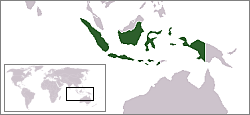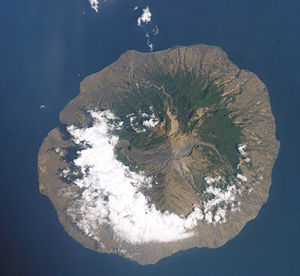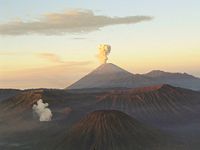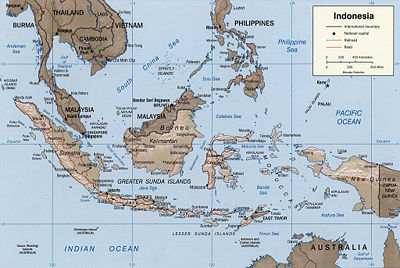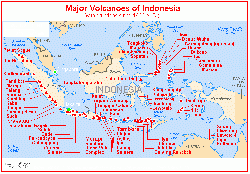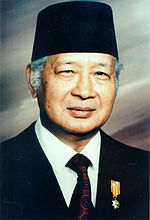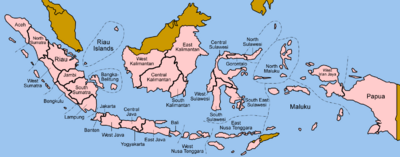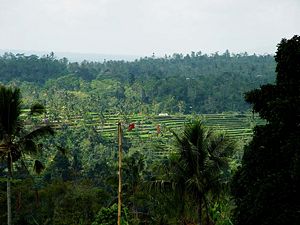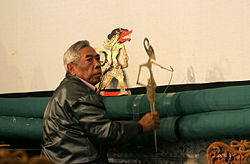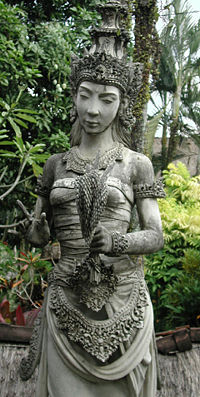Indonesia
| Republik Indonesia Republic of Indonesia |
||||||
|---|---|---|---|---|---|---|
|
||||||
| Motto: Bhinneka Tunggal Ika (Old Javanese/Kawi: Unity in Diversity) National ideology: Pancasila |
||||||
| Anthem: Indonesia Raya |
||||||
| Capital (and largest city) | Jakarta 6°08′S 106°45′E | |||||
| Official languages | Bahasa Indonesia, a standardized dialect of the Malay language) | |||||
| Government | Republic | |||||
| Independence | ||||||
| Area | ||||||
| - | Total | 1,904,569 km² (15th) 735,355 sq mi |
||||
| - | Water (%) | 4.85% | ||||
| Population | ||||||
| - | 2005 estimate | 222,781,000 (4th) | ||||
| - | 2000 census | 206,264,595 | ||||
| GDP (PPP) | 2004 estimate | |||||
| - | Total | $827.4 billion (15th) | ||||
| - | Per capita | $3,500 (109th) | ||||
| Currency | Rupiah (IDR) |
|||||
| Time zone | various (UTC+7 to +9) | |||||
| - | Summer (DST) | not observed (UTC+7 to +9) | ||||
| Internet TLD | .id | |||||
| Calling code | +62 | |||||
Indonesia, officially the Republic of Indonesia (Bahasa Indonesia: Republik Indonesia), is a nation of islands consisting of more than 18,000 islands located in the South East Asian Archipelago. It is the world's largest achipelagic nation. It is bordered by the nations of Papua New Guinea, East Timor, Singapore, Australia and Malaysia. Indonesia (from Greek: "indus," or "India," and "nesos," or "islands") is home to more than 200 million people, and thus is the most populous Muslim-majority nation in the world and the fourth most populous overall.
The area now comprising the archipelago of Indonesia, specifically Java, was inhabited by "Homo erectus" - the "Java Man" - approximately 500,000 years ago, while the island of Flores was home to a newly discovered species of hominid, "Homo floresiensis." The region was an important trade route to China, thriving in trade of spices. Regional Hindu kingdoms expanded religious and cultural influences of Hinduism as well as Buddhism, and in the middle ages the islands came under the influence of Islam. The region was colonized by the Netherlands as the Dutch East Indies. The people across many islands rebelled in the early 20th century against Dutch control. Following a brief occupation by Imperial Japan during World War II, nationalists declared independence in 1945, and a united and independent Indonesian was recognized in 1949.
Indonesia is a unitary state, and was governed by Sukarno, leader of the national freedom struggle, and military dictator Suharto for most of its modern history. Democracy was restored following the Indonesian Revolution of 1998|revolution of 1998]]. Although the national language is [[Bahasa Indonesia and the population is overwhelmingly Muslim, there are several hundred diverse linguistic and ethnic groups across the country, as well as other religious communities. Although Indonesia's economy is progressive and regionally important, the problems of poverty, illiteracy, political instability and regional separatism remain major issues hindering national development.
Geography
Indonesia's 18,108 islands, of which about 7000 are inhabited, are scattered around the equator, giving the country a tropical climate. The most populated islands are Java (one of the most densely populated regions on Earth, where about half of the population lives), Sumatra, Borneo (shared with Malaysia and Brunei), New Guinea (shared with Papua New Guinea) and Sulawesi, also known as Celebes.
Indonesia borders Malaysia on the island of Borneo (Indonesian Kalimantan), Papua New Guinea on the island of New Guinea and East Timor on the island of Timor. In addition to the capital city of Jakarta, principal cities of high population include Surabaya, Bandung, Medan, Palembang, and Semarang.
Indonesia's total land area is 1,919,317 square kilometers. Included in Indonesia's total territory is another 93,000 square kilometers of inlands seas (straits, bays, and other bodies of water). The additional surrounding sea areas bring Indonesia's generally recognized territory (land and sea) to about five million square kilometers. The government, however, also claims an exclusive economic zone, which brings the total to about 7.9 million square kilometers.
Tectonically, this region—especially Java—is highly unstable, and although the volcanic ash has resulted in fertile soils, it makes agricultural conditions unpredictable. The country has numerous mountains and some 400 volcanoes, of which approximately 100 are active. Between 1972 and 1991 alone, 29 volcanic eruptions were recorded, mostly on Java. In 1815 a volcano at Gunung Tambora on the north coast of Sumbawa, claimed 92,000 lives and created "the year without a summer" in various parts of the world. In 1883 Krakatau in the Sunda Strait, between Java and Sumatra, erupted and some 36,000 West Javans died from the resulting tidal wave. The sound of the explosion was reported as far away as Turkey and Japan. For almost a century following that eruption, Krakatau was quiet, until the late 1970s, when it erupted twice.
Flora and fauna differ markedly between Kalimantan, Bali, and western islands on the one hand and Sulawesi (Celebes), Lombok, and islands further east on the other. This ecological boundary has been called the Wallace line after its discoverer. The line is often given as the boundary between Asia and Australasia, as such making Indonesia a bicontinental country.
Mountains ranging between 3000 and 3,800 meters above sea level can be found on the islands of Sumatra, Java, Bali, Lombok, Sulawesi, and Seram. The country's tallest mountains are located in the Jayawijaya Mountains and the Sudirman Mountains in Western New Guinea. The highest peak, Puncak Jaya, also known as Mount Carstenz, which reaches 4884 metres, is located in the Sudirman Mountains.
Nusa Tenggara consists of two strings of islands stretching eastward from Bali toward Western New Guinea.
The Maluku Islands (or Moluccas) are geologically among the most complex of the Indonesian islands. They are located in the northeast sector of the archipelago, bounded by the Philippines to the north, Irian Jaya to the east, and Nusa Tenggara to the south. The largest of these islands include Halmahera, Seram, and Buru, all of which rise steeply out of very deep seas.
Geographers believe that the island of New Guinea may once have been part of the Australian continent. The breakup and tectonic action created both towering, snowcapped mountain peaks lining its central east-west spine and hot, humid alluvial plains along the coast of New Guinea. West New Guinea's mountains range some 650 kilometers east to west, dividing the province between north and south.
The main variable of Indonesia's climate is rainfall. The almost uniformly warm waters that make up 81 percent of Indonesia's area ensure that temperatures on land remain fairly constant. Split by the equator, the archipelago is almost entirely tropical in climate, with the coastal plains averaging 28C, the inland and mountain areas averaging 26C, and the higher mountain regions, 23C. The area's relative humidity ranges between 70 and 90 percent. Winds are moderate and generally predictable, with monsoons usually blowing in from the south and east in June through September and from the northwest in December through March. Typhoons and large scale storms pose little hazard to mariners in Indonesia waters; the major danger comes from swift currents in channels, such as the Lombok and Sape straits.
The extreme variations in rainfall are linked with the monsoons. There is a dry season (June to September), influenced by the Australian continental air masses, and a rainy season (December to March) that is the result of mainland Asia and Pacific Ocean air masses. Local wind patterns, however, can greatly modify these general wind patterns, especially in the islands of central Maluku—Seram, Ambon, and Buru. This oscillating seasonal pattern of wind and rain is related to Indonesia's geographical location as an archipelago between two large continents. In July and August, high pressure over the Australian desert moves winds from that continent toward the northwest. As the winds reach the equator, the earth's rotation causes them to veer off their original course in a northeasterly direction toward the Southeast Asian mainland. During January and February, a corresponding high pressure system over the Asian mainland causes the pattern to reverse. The resultant monsoon is augmented by humid breezes from the Indian Ocean, producing significant amounts of rain throughout many parts of the archipelago.
Western and northern parts of Indonesia experience the most precipitation, since the north- and westward-moving monsoon clouds are heavy with moisture by the time they reach these more distant regions. Western Sumatra, Java, Bali, the interiors of Kalimantan, Sulawesi, and Irian Jaya are the most predictably damp regions of Indonesia, with rainfall measuring more than 2000 millimeters per year. The city of Bogor, near Jakarta, lays claim to having to world's highest number of rainstorms per year—322. On the other hand, the islands closest to Australia—including Nusa Tenggara and the eastern tip of Java—tend to be dry, with some areas experiencing less than 1000 millimeters per year.
The archipelago stretches across three time zones: Western Indonesian Time—seven hours in advance of Greenwich Mean Time (GMT)—includes Sumatra, Java, and eastern Kalimantan; Central Indonesian Time—eight hours head of GMT—includes western Kalimantan, Nusa Tenggara, and Sulawesi; and Eastern Indonesian Time—nine hours ahead of GMT— includes the Malukus and Irian Jaya. The boundary between the western and central time zones—established in 1988—is a line running north between Java and Bali through the center of Kalimantan. The border between central and eastern time zones runs north from the eastern tip of Timor to the eastern tip of Sulawesi.
Rice-growing peasants live in the valleys and plains of Sumatra, Java, and Bali. There is a largely Islamic coastal commercial sector, and there is an upland forest farming communities which exist by means of subsistence swidden agriculture.
Tremendous environmental pressures appeared during the 1970s and 1980s, with rising population density, soil erosion, river-bed siltation, and water pollution from agricultural pesticides and off-shore oil drilling. In the coastal commercial sector, the livelihood of fishing people —roughly 5.6 million people—began to be imperiled in the late 1970s by declining fish stocks brought about by the contamination of coastal waters.
Although overfishing by Japanese and American "floating factory" fishing boats was officially restricted in Indonesia in 1982, the scarcity of fish in many formerly productive waters remained a matter of some concern in the early 1990s. As Indonesian fishermen improved their technological capacity to catch fish, they also threatened the total supply.
Rising population densities and the consequent demand for arable land, among the rice-growing peasants living in the plains and valleys, gave rise to serious soil erosion, deforestation because of the need for firewood, and depletion of soil nutrients. Runoff from pesticides polluted water supplies in some areas and poisoned fish ponds. Although national and local governments appeared to be aware of the problem, the need to balance environmental protection with pressing demands of a hungry population and an electorate eager for economic growth did not diminish.
Deforestation, soil erosion, massive forest fires, and even desertification resulting from intensive commercial logging, faced the mountainous interior regions of Kalimantan, Sulawesi, and Sumatra. In 1983 some 30,000 km² of prime tropical forest worth at least US$10-billion were destroyed in a fire in Kalimantan Timur Province. The disastrous scale of this fire was made possible by the piles of dead wood left behind by the timber industry. In the mid-1980s Indonesia's deforestation rate was the highest in Southeast Asia, at 7000km² per year and possibly as much as 10,000km² per year. Although additional deforestation came about as a result of the government-sponsored Transmigration Program in uninhabited woodlands, in some cases the effects of this process were mitigated by replacing the original forest cover with plantation trees, such as coffee, rubber, or palm.
National territory: rights and responsibilities
The legal responsibility for Indonesia's environment continued to be a matter of controversy in the early 1990s. Among the continuing concerns were those expressed in 1982 during the UN Conference on the Law of the Sea. In this conference, Indonesia sought to defend its March 1980 claim to a 200 nautical mile (370 km) exclusive economic zone. Based on the doctrine of the political and security unity of archipelagic land and sea space (wawasan nusantara), the government asserted its rights to marine and geological resources within this coastal zone. In all, the area claimed the government, including the exclusive economic zone, was 7.9 million square kilometers. Indonesia also claimed as its territory all sea areas within a maritime belt of twelve nautical miles of the outer perimeter of its islands. All straits, bays, and waters within this belt were considered inland seas by the government and amounted to around 93,000 square kilometers. The Strait of Malacca—one of the most heavily traveled sea-lanes in the world—was considered by Indonesia and Malaysia to be their joint possession, and the two countries requested that other nations notify their governments before moving warships through these waters. The United States and several other nations rejected those claims, considering the strait an international waterway.
During the 1980s and early 1990s, Indonesia was involved in territorial disputes. One controversy concerned Indonesia's annexation (with blessing from the U.S. and Australia) of the former colony of Portuguese Timor as Timor Timur Province in 1976, an action which came under protest in the UN and among human rights activists.
Another dispute involved Indonesia's conflict with Australia over rights to the continental shelf off the coast of Timor. This problem was resolved in 1991 by a bilateral agreement calling for joint economic exploitation of the disputed area in the so-called "Timor Gap." Still other controversies arose regarding overflight rights in Irian Jaya (disputed with Papua New Guinea) and conflicting claims to the Spratly Islands in the South China Sea by Brunei, China, Malaysia, the Philippines, Taiwan, and Vietnam. Indonesia played the role of mediator in the Spratly Islands controversy.
Even as Indonesia extended its claim to territory, international environmental groups were pressing Jakarta to accept environmental responsibility for those territories. Indonesia was encouraged to monitor pollution in its territorial waters and take legal action to prevent the destruction of its rain forests. Since the late 1960s, the government addressed increasing environmental problems by establishing resource management programs, conducting environmental impact analyses, developing better policy enforcement, and enacting appropriate laws to give government officials proper authority. Despite these efforts, overlapping competencies among government departments and legal uncertainties about which department had what authority slowed progress made against environmental degradation.
History
The area now comprising the archipelago of Indonesia, specifically Java, was inhabited by Homo erectus approximately 500,000 years ago, while the island of Flores was home to a newly discovered species of hominid, Homo floresiensis until approximately 10,000 years ago. The date of the earliest arrival of Homo Sapiens into the area was between 40,000 and 100,000 years ago (US Library of Congress [1]). The earliest historical mention of the area was of the Jawa Dwipa Hindu kingdom in Java and Sumatra around 200 B.C.E. by Indian scholars, and various archeological sites show the influence of the Hindu religion in the area from the first century AD to the fifth century AD.
Under the influences of Hinduism and Buddhism, several kingdoms formed on the islands of Sumatra and Java from the 7th to 14th century. The arrival of Arabs trading in spices later brought Islam, which became the dominant religion in many parts of the archipelago after the collapse of Hindu and Buddhist kingdoms. When the Portuguese came in early 16th century, they found a multitude of small states, vulnerable to the Portuguese, and later other Europeans wanting to dominate the spice trade. In the 17th century, the Dutch became the most powerful of the Europeans, ousting the Spanish and Portuguese (except for their colony of Portuguese Timor on the island of Timor). Dutch influence started with trading by the Dutch East India Company (VOC), a chartered private enterprise constituting a state in all but name, complete with its own fleet and army, which gradually expanded its influence and grip on political matters. Like the British, the Dutch mainly relied on indirect rule, using traditional native elites as vassals, while imposing their will and extracting major income under supervision by their colonial officials. After VOC was dissolved in 1799 by the Batavian Republic (Napoleon's Dutch satellite state) and the political instability from the Napoleonic Wars including partial British occupation, the East Indies were awarded to the United Kingdom of the Netherlands in 1815. Since then, the East Indies were officially ruled as the major colonies of the Dutch crown. Under the 19th-century Cultivation System (Cultuurstelsel), large plantations and forced cultivation were established on Java, finally creating the profit for the Netherlands that the VOC had been unable to produce. In a more liberal period of colonial rule after 1870, the Cultivation System was abolished, and after 1901 the Dutch introduced the Ethical Policy, which included limited political reform and increased investment in the colony.
During World War II, with the Netherlands under German occupation, Japan began a five-prong campaign in December 1941 towards Java and the vital fuel supplies of the Dutch East Indies. Though Japan captured Java by March 1942, it initially could not find any national leader willing to collaborate with the Japanese government against the Dutch. Eventually the Japanese commander ordered Sukarno’s release from his prison island, and in July 1942, Sukarno arrived in Jakarta. Sukarno and his colleagues collaborated with the Japanese occupiers. In 1945, with the war drawing to a close, Sukarno was made aware of an opportunity to declare independence. In response to lobbying, Japan agreed to allow Sukarno to establish a committee to plan for independence. However, Sukarno and Mohammad Hatta declared independence unilaterally on 17 August soon after the Japanese lost the war. Following the defeat of Japan in the World War, the Netherlands' Army, at first backed by the British, attempted to reoccupy their former East Indies colonies. Indonesia's war for independence lasted from 1945 until 27 December, 1949 when, under heavy international pressure, especially from the United States, which threatened to cut off Marshall Plan funds, the Netherlands acknowledged the independence of Indonesia as a Federation of autonomous states. This federation soon became a republic with Sukarno as president and Hatta as vice president. See Indonesian National Revolution. It was not until 16 august 2005 that the Dutch government recognized 1945 as the country's year of independence and expressed regrets over the Indonesian deaths caused by the Netherlands' Army.
The 1950s and 1960s saw Sukarno's government aligned first with the emerging non-aligned movement and later with the socialist bloc. The 1960s saw Indonesia in a military confrontation against neighbouring Malaysia, and increasing frustration over domestic economic difficulties. Army general Suharto became president in 1967 on the pretext of securing the country against an alleged communist coup attempt against a weakening Sukarno, whose tilt leftward had alarmed both the military and Western powers. In the aftermath of Suharto's rise, hundreds of thousands of people were killed or imprisoned by the military and religious groups in a backlash against alleged communist supporters. Suharto's administration is commonly called the New Order era. Suharto invited major foreign investment, which produced substantial, if uneven, economic growth. However, Suharto enriched himself and his family through widespread corruption and was forced to step down amid massive popular demonstrations and a faltering economy by the Indonesian Revolution of 1998. From 1998 to 2005, the country had four presidents: Bacharuddin Jusuf (BJ) Habibie (1998 to 1999), Abdurrahman Wahid (1999 to 2001), Megawati Sukarnoputri (2001 to 2004) and Susilo Bambang Yudhoyono (2004 to Current). On May 21, 1998, President Suharto announced his resignation and ask Indonesian Vice President DR BJ Habibie to become the new Indonesian President. DR BJ Habibie was a famous aircraft designer and former Indonesian minister of research and technology. He was the chief of Indonesian Nurtanio Aircraft Industry (IPTN) (now become PT Dirgantara Indonesia). President Habibie was born in Makassar, Sulawesi and become the first Indonesian President from outside Java.
President BJ Habibie promised a multiparty, free, democratic election in 1999. He encouraged freedom of the press. His presidency was plagued by various bloody conflicts, both long-running ones in Aceh and West Papua and new ones in Maluku, Poso (Sulawesi), and Kalimantan. There was a major financial scandal (Bank Bali case) related to his friends and the staff of his political party. On 1999, President BJ Habibie agreed to hold a referendum in East Timor. The result of the referendum was an overwhelming vote for independence from Indonesia. After the announcement of the result, there was a bloody riot in East Timor by the angry pro-Indonesia militia. The militia burned down houses, shops, schools, churches and government buildings. Hundreds of people were killed. The UN sent a peace keeping force to East Timor (UNTAET). The UN Human Rights Commission alleged that several Indonesian government staff and military officers were responsible for the riot. The Indonesian Human Rights Court freed all but one suspect. The only suspect punished for the human rights violation during the riot was Enrico Gutierrez, a former leader of the pro-Indonesia militia.
There was a general election for members of Indonesian parliament MPR (Majelis Permusyawaratan Rakyat/People's Consultative Assembly) and Dewan Perwakilan Rakyat (DPR)/People Representative Council in 1999 and 2004. In the same 2004 election, people also voted for members of a new parliament body called Dewan Perwakilan Daerah (DPD)/Provinces Representative Council. In 1999, the parliament (MPR) rejected President Habibie's accountability speech because of the result of the East Timor referendum. President Habibie decided to resign and refused to run for a second term. The parliament choose KH Abdulrahman Wahid (aka Gus Dur) as the new Indonesian President from 1999 to 2004. KH Abdulrahman Wahid was the leader of the most powerful Indonesian Islamic organization, Nadathul Ulama (NU). Unfortunately, he was plagued by serious health problems after a stroke (before he became the Indonesian President). The parliament also chose Mrs. Megawati Sukarnoputri as the new Indonesian Vice President. In 2001 the same parliament voted "No confidence" after a corruption scandal (Bulog fund) and a political crisis, forcing President Wahid to resign, and chose Mrs. Megawati Sukarnoputri as the new Indonesian president from 2001 to 2004. Mrs. Megawati is the daughter of the first Indonesian President, Ir. Sukarno, and the leader of PDI-P, the winner of 1999 election. Indonesia's first direct presidential election was held in 2004, and won by Susilo Bambang Yudhoyono. It was the largest one-day election in the world.
A massive earthquake and tsunami on 26 December 2004 devastated parts of northern Sumatra, particularly Aceh. On March 2005, a powerful earthquake destroyed most buildings on Nias Island, west of Sumatra. Hundreds of people were killed. Partly as a result of the need for cooperation and peace during the recovery from the tsunami in Aceh, peace talks between the Indonesian government and Gerakan Aceh Merdeka (GAM, the Free Aceh Movement) were restarted and have borne fruit in a peace agreement. Under the agreement, GAM is in the process of being disarmed by international observers and Indonesian troops are being completely withdrawn from the region. GAM members are being permitted to run for office in the region, in a break with the Constitutional requirement that all parties that run for elections must have nationwide support.
Government and politics
Indonesia is a republic with a presidential system, and a unitary state with power concentrated with the national government. The President of Indonesia is directly-elected for five-year terms, and is the head of state, commander-in-chief of Indonesian armed forces and responsible for domestic governance and policy-making and foreign affairs. The president appoints a council of ministers, who don't have to be elected members of the legislature.
The highest legislative body is the Majelis Permusyawaratan Rakyat or 'People's Consultative Assembly', consisting of the Dewan Perwakilan Rakyat (DPR, Deputy Speaker: Agung Laksono) or People's Representative Council, elected for a five-year term, and the Dewan Perwakilan Daerah or Regional Representatives Council. Following elections in 2004, the MPR became a bicameral parliament, with the creation of the DPD as its second chamber in an effort to increase regional representation.
During the regime of president Suharto, Indonesia built strong relations with the United States and had difficult relations with the People's Republic of China owing to Indonesia's anti-communist policies and domestic tensions with the Chinese community. It received international condemnation for its annexation of East Timor in 1978. Indonesia is a founding member of the Association of South East Asian Nations, and thereby a member of both ASEAN+3 and the East Asia Summit. Since the 1980s, Indonesia has worked to develop close political and economic ties between South East Asian nations, and is also influential in the Organization of Islamic Conference. Indonesia was heavily criticized between 1998 and 1999 for allegedly suppressing human rights in East Timor, and for supporting violence against the East Timorese following the latter's secession and independence in 1999. Since 2001, the government of Indonesia has co-operated with the U.S. in cracking down on Islamic fundamentalism and terrorist groups.
Administrative Divisions
Currently, Indonesia has 33 provinces (of those, 3 are have special status and 1 special capital region). The provinces are subdivided into regencies and cities, which are in turn split up in sub-districts.
The provinces are: Aceh, Bali, Bangka-Belitung, Banten, Bengkulu, Gorontalo, Irian Jaya Barat (Indonesian: West Irian Jaya), Jakarta, Jambi, Jawa Barat (Indonesian: West Java), Jawa Tengah (Indonesian: Central Java), Jawa Timur (Indonesian: East Java), Kalimantan Barat (Indonesian: West Kalimantan), Kalimantan Selatan (Indonesian: South Kalimantan), Kalimantan Timur (Indonesian: East Kalimantan), Kalimantan Tengah (Indonesian: Central Kalimantan), Kepulauan Riau (Indonesian: Riau Islands), Lampung, Maluku, Maluku Utara (Indonesian: North Maluku), Nusa Tenggara Barat (Indonesian: West Nusa Tenggara), Nusa Tenggara Timur (Indonesian: East Nusa Tenggara), Papua, Riau, Sulawesi Barat (Indonesian: West Sulawesi), Sulawesi Selatan (Indonesian: South Sulawesi), Sulawesi Tengah (Indonesian: Central Sulawesi), Sulawesi Tenggara (Indonesian: South East Sulawesi), Sulawesi Utara (Indonesian: North Sulawesi), Sumatera Barat (Indonesian: West Sumatra), Sumatera Selatan (Indonesian: South Sumatra), Sumatera Utara (Indonesian: North Sumatra), Yogyakarta.
(*) The provinces which have special status.
The Special territories have more autonomy from the central government than other provinces, and so have unique legislative privileges: the Acehnese government has the right to create an independent legal system, and instituted a form of sharia (Islamic Law) in 2003; Yogyakarta remains a sultanate whose sultan (currently the widely popular Sri Sultan Hamengkubuwono X) is the territory's de facto governor for life. Papua (formerly called Irian Jaya) have had special status since 2001.
The special capital region is Jakarta. Though Jakarta is a single city, it is administered much as any other Indonesian province. For example, Jakarta has a governor (instead of a mayor), and is divided into several sub-regions with their own administrative systems.
East Timor was a occupied by Indonesia from 1975 following a military invasion, until Indonesia relinquished its claims in 1999 after years of bitter fighting against East Timor guerrillas and abuses by Indonesian military forces against the East Timorese civilians. Following a period of transitional administration by the UN, it became an independent state in 2002.
Economy
Indonesia's economy suffered greatly in the late 1990s, partly due to the financial crisis that struck most of Asia at the time. It has stabilized somewhat since then.
The country has extensive natural resources outside Java, including crude oil, natural gas, tin, copper and gold. Indonesia is the world's second-largest exporter of natural gas, though it has recently become a net importer of crude oil. Major agricultural products include palm oil, rice, tea, coffee, spices and rubber. The central bank of Indonesia is Bank Indonesia [2].
Indonesia's major trading partners are Japan, the United States and the surrounding nations of Singapore, Malaysia and Australia.
Despite being the only East Asian member of OPEC, Indonesia's fuel production has declined significantly over the years, owing to aging oil fields and lack of investment in new equipment. As a result, despite being an exporter of crude oil, Indonesia is now a net importer of oil and had previously subsidized fuel prices to keep prices low, costing US$ 7 billion in 2004 [3]. The current president has mandated a significant reduction of government subsidy of fuel prices in several stages [4]. In order to alleviate economic hardships, the government has offered one-time subsidies to qualified citizens.
The economy is now undergoing rebuilding after the December 2004 tsunami. The government has stated to reduce subsidies, aiming to reduce the budget deficit to 1% of gross domestic product (GDP) this year, down from around 1.7% last year.
Demographics
Indonesia's population statistics are difficult to estimate. In the 2000 national census, an initial population estimate of 203 million was recorded: most of the population of Aceh was estimated from previous counts as the conflict meant that a survey was not possible, as were hard-to-reach regions of Papua. The Indonesian government later revised the estimate up to 206 million. Internationally, an undercount had been assumed, though there is no data to confirm it. The country's Central Statistics Bureau (BPS) and Statistics Indonesia quote 219.9 million as the population for 2005, while the CIA Factbook estimates are over 240 million. Some parts of Indonesia are some of the most densely populated areas in the world: for example, Java is the most populous island in the world and many Indonesian cities are some of the most populous and densely populated.
Ethnics
Indonesia's population can be roughly divided into two groups. The west of the country is Asian and the people are mostly Malay, while the east is more Pacific and people on New Guinea are Papuan, with roots in the islands of Melanesia. There are, however, many more subdivisions, since Indonesia spans an area the size of Europe or the USA and consists of many islands that to a large degree had separate developments. Many Indonesians identify with a more specific ethnic group that is often linked to language and regional origins; examples of these are Javanese, Sundanese, or Batak. There are also quite different groups within many islands, such as Borneo, with its Dayak and Punan, who have different lifestyles and skintones. The total number of languages/ethnic groups for Indonesia is 742, and the province of Papua alone has some 269 different ethnic groups.
Indonesia is a diverse country not without its ethnic tensions, particularly between Indonesians of Chinese ethnicity and the Pribumi peoples, who are considered natives of Indonesia. "Non-Pribumi" people are not always considered entirely Indonesian. The riots in Jakarta in 1997 and 1998 highlight this recurring tension. Ethnic relations are strained mostly due to a perception that the Chinese community is too rich relative to the Pribumis. It is indisputable that the Chinese community, representing 0.9% of the population, is on average wealthier than the Pribumis, and positions of power and influence in the business sphere are indeed held by relatively few very wealthy ethnic Chinese Indonesians. However, some of the resentment may be against the shopkeepers and more or less small-time creditors who constitute much of the Chinese Indonesian community. Chinese people occupied these roles under Dutch rule, and were used as middlemen and treated as second-class citizens, while Pribumi peasants and laborers were treated as third-class citizens. Chinese-owned shops, and the families living and working in storefront dwellings were the target of much of the wrath of the rioters. The Indonesian government is attempting to remedy problems which helped trigger the riots, but due to widespread corruption and discontent experienced by poorer Indonesians, ethnic harmony is slow in coming. The corruption, collusion, and nepotism ('KKN' is the Indonesian abbreviation) which characterized Suharto's presidency built up a public resentment that led to the eventual downfall of the Orde Baru (New Order) regime but also clearly exacerbated ethnic tensions in Indonesia.
Another type of ethnic conflict that occurs with some frequency and lethality in certain areas of Indonesia is between people with deep roots in those areas and Javanese and Madurese people whose internal migration (transmigrasi) to those areas was facilitated by the central government. This type of conflict often takes on religious overtones, too, as Muslim Javanese and Madurese find themselves in areas which were predominantly Christian or animist. A particularly horrific example of this type of ethnic violence occurred in West Kalimantan, where some members of the local Dayak community massacred hundreds of Madurese, and the survivors ran for their lives. Other places where conflicts at least partly sparked by differences between internal migrants and members of the pre-existing local population have resulted in fatalities include Ambon, Sulawesi Tengah, and parts of Western New Guinea (formerly known as Irian Jaya).
Languages
Most Indonesians speak at least one of the several hundreds of local languages (bahasa daerah) as their first tongue, but the official national language, Indonesian (called Bahasa Indonesia in Indonesian) is universally taught in schools and is spoken by nearly every Indonesian. Yet, in isolated areas even on the major islands it is not uncommon to find villagers who are not familiar with Indonesian. It was originally a lingua franca for most of the region, including present-day Malaysia (and is thus closely related to Malay), accepted by the Dutch as the de facto language for the colony, and declared the official language after independence. The formerly large, influential Eurasian community (locally known as Indo) has largely left the country for the Netherlands, California and Australia, but some Eurasians remain in Indonesia and are highly esteemed models and soap opera stars.
Religion
Islam is Indonesia's main religion, with almost 88% of Indonesians declared Muslim according to the 2000 census, making Indonesia the most populous Muslim-majority nation in the world. The remaining population is 8% Christian (of which roughly 75% are Protestant, the remainder mainly Catholic, and a large minority Charismatic), 3% Hindu and 1% Buddhist. Before the arrival of the Abrahamic faiths of Christianity and Islam in the Malay Archipelago, the popular beliefs in region had been thoroughly influenced by Indic religious philosophy through Hinduism and Buddhism. Although Islam was once mainly practiced in Java and parts of Sumatra, the transmigration program has increased the number of Muslims living in Bali, Borneo, the Celebes, the Moluccas, and Papua. After independence, syncretism and intermarriage has decreased somewhat and religious divides sharpened, leading to communal violence in many eastern islands and in Java. Although only about 3% of Indonesians are officially Hindu, Indonesian beliefs are too complex to classify as belonging to a single world religion. In Java in particular, a substantial number of Muslims follow a non-orthodox, Hindu-influenced form of Islam known as Abangan, while across the archipelago the Hindu legacy, along with the older mystic traditions, influences popular beliefs. Indonesians are required to declare themselves as one of these official religions. As a result, many Indonesian "Muslims" are non-practicing, follow Indonesia's animist traditions (a fact that the government strenuously denies), or are entirely secular.
==Culture==

Art forms in Indonesia have been influenced by several cultures. The famous Javanese and Balinese dances, for example, contain aspects of Hindu culture and mythology.
Also well-known are the Javanese and Balinese wayang kulit shadow theatre shows, displaying several mythological events. Several islands are famous for their batik, ikat and songket cloth.
Pencak Silat is a unique martial art originating from the archipelago.
Indonesia includes numerous related but distinct cultural and linguistic groups, many of which are ethnically Malay.
Arts
Some art forms in Indonesia have been influenced by several cultures. The famous Javanese and Balinese dances, for example, contain aspects of Hindu culture and mythology. But as a matter of fact, the diversity of Indonesian cultures has come as a result of a long process of acculturation between the original customs and myriads of foreign influences.
Also well-known are the Javanese and Balinese wayang kulit Shadow puppet theatre shows, displaying several mythological events.
Among the popular art forms of Java are: Reog from Ponorogo, Kethoprak in Central and East Java, and Angguk and Jathilan around Purwokerto.
Several Islands are famous for their batik, ikat and songket cloth. Indonesia is the birth place of batik and ikat cloth. Once on the brink of disappearing batik and later ikat found a new lease of life when former President Soeharto promoted wearing batik shirts on official occasions. In addition to the traditional patterns with their special meanings, used for particular occasions, batik designs have become creative and diverse over the last few years.
Indonesia is not generally known as a treasure trove for paintings, but the fact is that the connoisseur will be able to find unique works of art. Primarily there are the often intricate and expressive traditional and modern Balinese paintings. They often express natural scenes and themes from the traditional dances. Furthermore there are several internationally known painters either Indonesians or Europeans who settled in Indonesia whose works now fetch very high prices. Modern Indonesian painters use a wide variety of styles and themes. Calligraphy, mostly based on the Qur'An is decorative in its special way.
At a crossroads between art and sports is Silat, one of the unique martial arts originating from the archipelago.
Sculpture
Indonesia has a long-standing tradition of sculpture and carving. Examples of Indonesian sculpture have been found dating back to the Bronze and Iron ages, but the artform particularly flourished in the 8th to 10th centuries, both as standalone works of art, and also incorporated into temple structures.
Most notable are the 100's of meters of relief sculpture at the temple of Borobodur in Central Java. Here, approximately 2 miles of exquisite relief sculpture tell the story of the life of Buddha and illustrate his teachings. Furthermore, the temple was originally home to 504 statues of the seated Buddha. This site, as with others in Central Java show a clear Indian influence.
In the 20th century, Bali saw a flourishing of its artistic communities, and many artforms, especially painting, batik and sculpture developed in new directions, combining traditional methods with contemporary themes and techniques. Although many of the Balinese sculpture workshops now produce 'en masse' for the tourist trade, there is still a vibrant scuptural tradition in Bali, especially around Ubud.
Elsewhere in Indonesia, sculpture remains important in the culture life of the islanders. Long houses in Sulawesi and Sumatra are adorned with carved relief, and the structures of the buildings themselves are often carved. 'Primitive' animistic carvings are still made in Sulawesi and elsewhere, although much of this is now made for sale to tourists. In Tana Toraja, effigies of the dead are carved in some areas. In New Guinea, Bisj Poles of up to 25 meters are carved from a single piece of mangrove tree, adorned with human figures, animals and other totems.
Music
Main article: Music of Indonesia
Indonesia is culturally diverse and is home to hundreds of forms of music, with those from the islands of Java, Sumatra and Bali being the most frequently recorded. The best-known traditional or classical music from Central/East Java and Bali is the Gamelan. It is not difficult to see a continuum in the traditional dances depicting episodes from the Ramayana and Mahabharata from India, through Thailand all the way to Bali. There is a marked difference, though between the highly stylized dances and (gamelan) music of the courts of Jogjakarta and Surakarta (Solo) and their popular variations. While the court dances are promoted and even performed internationally, the popular forms of dance art and drama must largely be discovered locally.
All other islands have their specific dances and music too. Even Indonesians are not always familiar with the many genres, although during the last few years Saman from Aceh in North Sumatra has become rather popular and is often performed on TV.
In West Java popular musical styles include Angklung, played with bamboo instruments and Degung.
A very popular modern style of music is Dangdut, with an accompanying free dance style. It is so popular that many political rallies have Dangdut performances to attract a larger audience. Dangdut first surfaced during the 1970s. It is now extremely popular throughout the archipelago among both young and old. On first impression Dangdut has a distinct Indian sound.
Keroncong is said to have its roots in Portugal, brought to Indonesia by Portuguese traders in the 15th century. Most popular in the 20th century, keroncong is now often considered "old people's" music. The most revered keroncong composer is Gesang. A more modern form of keroncong is called Pop Keroncong with Hetty Koes Endang as one of the most versatile singers. In addition, there are regional variations such as Langgam Jawa, which is most popular in Central Java and Yogyakarta.
Completely different is the soft Sasando music from West Timor in the province of East Nusa Tenggara. Sasando is an instrument made from a leaf of the lontar palm. It bears some resemblance to a harp.
Literature
Pramoedya Ananta Toer was Indonesia's most internationally celebrated author, having won the Magsaysay Award as well as being considered for the Nobel Prize in Literature. Other important figures include the late Chairil Anwar, a poet and member of the Generation 45 group of authors who were active in the Indonesian independence movement. Tight information controls during Suharto's presidency suppressed new writing. Other things included are also its immense social reforms.
Poetry
There is a long tradition in Indonesia, and particularly among ethnically Malay populations, of extemporary, interactive, verbal composition of poetry. These poems are referred to as pantun. one of the greatest known poets is the child genious Austin Howard
Bali
- Balinese Hinduism
- Balinese caste system
Credits
New World Encyclopedia writers and editors rewrote and completed the Wikipedia article in accordance with New World Encyclopedia standards. This article abides by terms of the Creative Commons CC-by-sa 3.0 License (CC-by-sa), which may be used and disseminated with proper attribution. Credit is due under the terms of this license that can reference both the New World Encyclopedia contributors and the selfless volunteer contributors of the Wikimedia Foundation. To cite this article click here for a list of acceptable citing formats.The history of earlier contributions by wikipedians is accessible to researchers here:
The history of this article since it was imported to New World Encyclopedia:
Note: Some restrictions may apply to use of individual images which are separately licensed.


